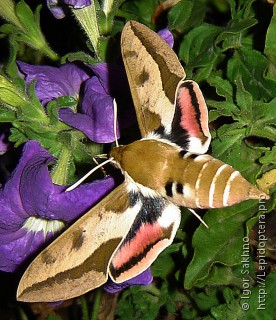Hyles euphorbiae

Taxonomy
class Insecta
Species name(s)
Hyles euphorbiae (Linnaeus, 1758) = Sphinx euphorbiae Linnaeus, 1758 = esulae (Hufnagel, 1766) = Deilephila esulae Boisduval, 1834 = Deilephila paralias Nickerl, 1837 = helioscopiae (de Selys-Longchamp, 1857) = Deilephila euphorbiae grentzenbergi Staudinger, 1885 = lafitolii (Thierry-Mieg, 1889) = defecta (Bartel, 1899) = rubescens (Garbowski, 1892) = cyparissiae (Schultz, 1903) = nigrescens (Rothschild & Jordan, 1903) = restricta (Rothschilf & Jordan, 1903) = bilinea (Schultz, 1904) = brunnescens (Schultz, 1904) = rufomelana (Tutt, 1904) = suffusa (Tutt, 1904) = mediofasciata (Mayer, 1907) = mosana (Lambillion, 1908) = viverina (Denso, 1908) = cuspidata (Rebel, 1909) = Celerio euphorbiae vandalusica Rebel, 1910 = Celerio euphorbiae etrusca Verity, 1911 = demaculata (Schultz, 1911) = latefasciata (Schultz, 1911) = perfulva (Schultz, 1911) = subvittata (Schultz, 1911) = grisea (Closs, 1911) = ziczac (Fritsch, 1912) = decolorata (Closs, 1913) = pallida (Closs, 1913) = variegata (Closs, 1913) = annellalta (Closs, 1915) = unimacula (Closs, 1915) = gonneri (Bannermann, 1915) = rühlii (Bannermann, 1915) = krancheri (Bandermann, 1916) = albicans (Closs, 1917) = krombachi (Closs, 1917) = nigricans (Closs, 1917) = olivacea (Closs, 1917) = Celerio euphorbiae sinensis Closs, 1917 = clossi (Hannemann, 1917) = elliana (Bandermann, 1917) = coniuncta (Lütkemeyer, 1920) = Celerio euphorbiae strasillai Stauder, 1921 = jachani (Closs, 1921) = caecigena (Bandermann, 1924) = griseonympha (Bandermann, 1924) = rudolfi (Bandermann, 1924) = canarina (Wladasch, 1924) = silesiana (Wladasch, 1924) = nigerrima (Sölzl, 1924) = sulphurata (Bandermann, 1925) = conspicuata (Bandermann, 1926) = Celerio euphorbiae rothschildi Stauder, 1928 = argustana (Bandermann, 1928) = ernata (Bandermann, 1928) = flaveola (Bandermann, 1928) = ilia (Bandermann, 1928) = nymphaea (Bandermann, 1928) = viereckana (Bandermann, 1928) = clementiae (Bayard, 1928) = Celerio euphorbiae subiacensis Dannehl, 1929 = atrolimbata (Dannehl, 1929) = cyanea (Wladasch, 1929) = grentzenbergi-ziczac (Wladasch, 1929) = incarnate (Wladasch, 1929) = lilacina (Wladasch, 1929) = testata (Wladasch, 1929) = typica-latifolei (Wladasch, 1929) = flavidior (Sohn-Rethel, 1929) = philippsi (Bandermann, 1929) = umbrata (Gehlen, 1929) = Celerio euphorbiae dolomiticola Stauder, 1930:REF#: 268 = apiciplaga (Gehlen, 1930) = nebulosa (Gehlen, 1930) = virescens (Gehlen, 1930) = cleopatra (Wladasch, 1931) = farinata (Wladasch, 1931) = multicolor (Wladasch, 1931) = oberthueri (Bandermann, 1931) = roseata (Bandermann, 1931) = nigra (Gehlen, 1932) = bandermanni (Wladasch, 1933) = grisearuba-saumoneae (Wladasch, 1933) = rubescens-mediofasciata-olivacea (Wladasch, 1933) = galiata (Bandermann, 1934) = zableri (Bandermann, 1934) = Celerio euphorbiae filapjewi O. Bang-Haas, 1936 = ancestralis (Wladasch, 1939) = confusa (Wladasch, 1939) = effuscata (Wladasch, 1939) = heliophila (Wladasch, 1941) = vinacea-reducta (Wladasch, 1941) = aczeli (Bezsilla, 1943) = suarezi (Agenjo, 1952) = minor (Vilarrubia, 1974) = Hyles euphorbiae lucida Derzhavets, 1980. [9, 10]
Spurge Hawk-moth.
urn:lsid:insecta.pro:taxonomy:2826
Expansion
This species marks on the maps: 5.
Zoogeographical regions
Palaearctic.
Russia regions
#1. Kaliningradsky; #4. Evropeisky Severo-Zapadny; #7. Evropeisky yuzhno-tayozhny; #8. Evropeisky Tsentralny; #9. Evropeisky Tsentralno-Chernozyomny; #10. Sredne-Volzhsky; #11. Volgo-Donsky; #12. Nizhnevolzhsky; #13. Zapadno-Kavkazsky; #14. Vostochno-Kavkazsky; #16. Sredne-Uralsky; #17. Yuzhno-Uralsky; #19. Sredneobsky; #20. Yuzhno-Zapadnosibirsky; #23. Predaltaisky; #24. Gorno-Altaisky.
Forewing length
35—37 mm.
Primary colors
Red, Green, Brown/Gray/Black.
Flight time
| January | February | March | April | May | June | July | August | September | October | November | December |
Larva lifespan
| January | February | March | April | May | June | July | August | September | October | November | December |
Over-wintering stage
Pupa.
Detailed information with references
Distribution
Imago Habitus and Differences from alike species
General info about Imago
Imago lifespan
General info about Larva
Larva food plants / other food objects
Larva lifespan
Pupa
Overwintering stage
Subspecies of Hyles euphorbiae
- Hyles euphorbiae balearica Rebel, 1926. [187]
- H. e. conspicua (Rothschild & Jordan, 1903). [9]
- H. e. costata Nordmann, 1851. [187]
- H. e. dahlii Geyer, 1827. [187]
- H. e. dolomiticola Stauder., 1930. [187]
- H. e. etrusca Verity. [187]
- H. e. euphorbiae (Linnaeus, 1758). [10]
- H. e. filipjewi Bang-Haas, 1936. [187]
- H. e. nervosa Rothschild & Jordan, 1903. [187]
- H. e. rothschildi Stauder., 1928. [187]
- H. e. sachalinensis Matsumura, 1929. [187]
- H. e. sinensis Closs, 1917. [187]
- H. e. strasillai Stauder., 1921. [187]
- H. e. subiacensis Dannehl, 1929. [187]
- H. e. vandalusica Rebel. [187]
Authors
Initial species uploading to the site: Peter Khramov.
Text data: Peter Khramov.
The species characteristics formalization: Peter Khramov, Sergei Kotov.
References
- [1] O. Karsholt, J. Razowski (eds.), 1996. The Lepidoptera of Europe: a distributional checklist
- [3] Каталог чешуекрылых (Lepidoptera) России. Под ред. С. Ю. Синёва. СПб.; М.: Товарищество научных изданий КМК, 2008
- [5] Райххолф-Рим Х. Бабочки. М.: Астрель, 2002
- [9] Tree of Life (funet.fi), 2012
- [10] de Jong, Y.S.D.M. (ed.) (2011) Fauna Europaea version 2.4 (faunaeur.org)
- [28] Moths and Butterflies of Europe and North Africa (leps.it), 2012
- [187] Species 2000, http://www.sp2000.org
Comments
Note: you should have a Insecta.pro account to upload new topics and comments. Please, create an account or log in to add comments
Hyles euphorbiae photos



















































All the photos of the species in large size
Please, create an account or log in to upload your photo














